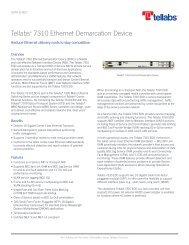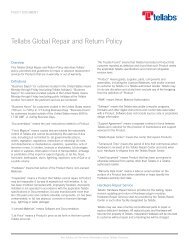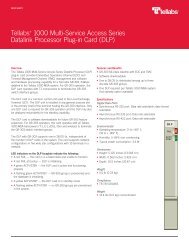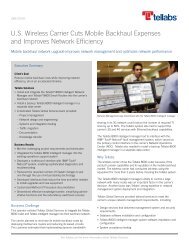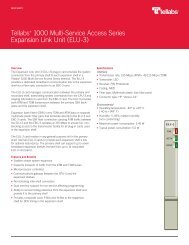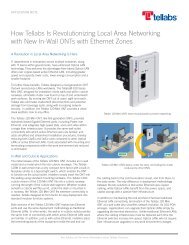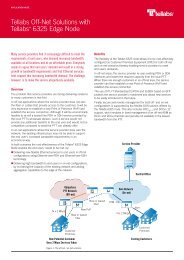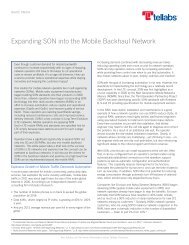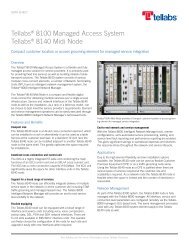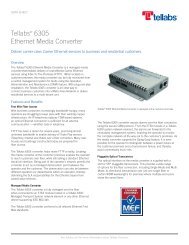Create successful ePaper yourself
Turn your PDF publications into a flip-book with our unique Google optimized e-Paper software.
Q4 2012<br />
Advance smart networks<br />
HELPING<br />
VODAFONE ITALY<br />
ADVANCE TO LTE<br />
The European carrier has relied<br />
on <strong>Tellabs</strong> solutions since 2010.<br />
Now it’s trialing <strong>Tellabs</strong> products<br />
as it prepares a move into<br />
the future.
4<br />
LEADING EDGE<br />
Tarcisio Ribeiro, <strong>Tellabs</strong> vice president, Europe, Middle<br />
East and Africa, discusses <strong>Tellabs</strong>’ commitment to<br />
customers as they face challenges around the globe.<br />
17<br />
THE FRENCH BROADBAND REVOLUTION<br />
How service provider CELESTE is expanding its fiberbased<br />
metro network to the largest cities in France.<br />
By M.J. Richter<br />
6<br />
UPLOAD<br />
Smartphones are taking on increased importance in<br />
users’ lives. Spending on software-defined networks<br />
increased from $80 million in 2010 to $140 million<br />
in 2011. And more.<br />
By Joan Engebretson<br />
22<br />
SMART MOBILE BACKHAUL IS KEY TO<br />
HET NET SUCCESS<br />
With the flexibility to adapt to changing technologies<br />
and services, operators can position themselves higher<br />
in the communications value chain.<br />
By Ian Volans<br />
11<br />
HELPING VODAFONE ITALY ADVANCE TO LTE<br />
The European carrier has relied on <strong>Tellabs</strong> solutions<br />
since 2010. Now it’s trialing <strong>Tellabs</strong> products as it<br />
prepares a move into the future.<br />
By Joan Engebretson<br />
28<br />
WHEN SMALLER IS STRONGER<br />
The new <strong>Tellabs</strong> 120 Mini ONT saves customers CapEx,<br />
OpEx and physical space. And you don’t have to worry<br />
about spilling coffee on it.<br />
By M.J. Richter<br />
Subscribe to Insight: www.tellabs.com/insight<br />
Insight Q4 2012 2
One <strong>Tellabs</strong> Center<br />
1415 West Diehl Road<br />
Naperville, IL 60563 USA<br />
Phone: +1.630.798.8800<br />
Fax: +1.630.798.2525<br />
www.tellabs.com<br />
Acting President and CEO<br />
Daniel P. Kelly<br />
Editorial Board<br />
George Stenitzer<br />
Tom Lynch<br />
Editor<br />
Tom Lynch<br />
Editorial Contributors<br />
Joan Engebretson<br />
M.J. Richter<br />
Design<br />
Herring Design<br />
Statements herein may contain projections or other forward-looking statements regarding future events, products,<br />
features, technology and resulting commercial or technological benefits and advantages. These statements are for<br />
discussion purposes only, are subject to change and are not to be construed as instructions, product specifications,<br />
guarantees or warranties. Actual results may differ materially. The following trademarks and service marks are owned<br />
by <strong>Tellabs</strong> Operations, Inc., or its affiliates in the United States and/or other countries: <strong>Tellabs</strong> ® , <strong>Tellabs</strong><br />
and T symbol ® , T symbol ® and SMARTCORE ® . Any other company or product names may be trademarks of their<br />
respective companies. Copyright ©2012 <strong>Tellabs</strong>. All rights reserved. 74.2231E<br />
Subscribe to Insight: www.tellabs.com/insight<br />
Insight Q4 2012 3
LEADING EDGE<br />
Focused on our customers’ success<br />
Tarcisio Ribeiro<br />
Vice President, Sales,<br />
Europe, Middle East and<br />
Africa<br />
All over the world, service providers face the challenge of exponential mobile data<br />
growth. Addressing user demand puts considerable strain on networks. What’s more,<br />
service providers need ways to maximize revenue and keep costs down.<br />
With our innovative solutions, <strong>Tellabs</strong> helps our customers overcome these challenges.<br />
Our products make customers’ networks smarter and simpler, so users around<br />
the globe can get what they need, exactly when they need it.<br />
We recently updated our mobile backhaul solution to help you move forward to LTE.<br />
And as service providers debate the needs of small cell networks, we’re here to help<br />
guide them to a more efficient backhaul infrastructure.<br />
Vodafone Italy is addressing the demand challenge by preparing to deploy a highercapacity<br />
mobile data network with LTE. Since 2010, <strong>Tellabs</strong> has provided backhaul<br />
connectivity for Vodafone’s 2G and 3G wireless networks. Now we’re in trials to help<br />
them make the crucial transition to LTE (page 11).<br />
CELESTE is expanding its fiber-based metro network to reach the 25 largest cities<br />
in France. So it needs a flexible network that can stay ahead of demand. That’s why<br />
CELESTE turned to the <strong>Tellabs</strong> ® 7100 Nano Optical Transport System. The <strong>Tellabs</strong><br />
7100 Nano OTS enables the network to provide 1-Gbps connections to 2,700 existing<br />
small/medium enterprise customers—and attract new customers as well (page 17).<br />
<strong>Tellabs</strong> has developed an innovative optical network terminal (ONT) that will revolutionize<br />
PONs and OLANs. The <strong>Tellabs</strong> ® 120 Mini Optical Network Terminal creates<br />
2G: Second Generation<br />
3G: Third Generation<br />
LTE: Long Term Evolution<br />
OLAN: Optical Local Area<br />
Network<br />
PON: Passive Optical Network<br />
Subscribe to Insight: www.tellabs.com/insight<br />
Insight Q4 2012 4
LEADING EDGE<br />
big savings in CapEx and OpEx, and gets rid of the clutter created by traditional desktop<br />
ONTs (page 28).<br />
Early this year, the number of mobile broadband subscriptions worldwide reached<br />
1 billion. As demand for mobile communications continues to soar, our industry is at<br />
an inflection point. Ian Volans argues that “smarter” backhaul can empower operators<br />
to position themselves higher in the communications value chain (page 22).<br />
<strong>Tellabs</strong> is dedicated to helping our customers win. By adding intelligence to your<br />
network, you can exceed user expectations and improve the quality of their experiences<br />
every day. <strong>Tellabs</strong> solutions enable you to take advantage of the tremendous opportunities<br />
our industry offers—we’re here to help you succeed.<br />
Sincerely,<br />
Tarcisio Ribeiro<br />
Vice President, Sales, Europe, Middle East and Africa<br />
Subscribe to Insight: www.tellabs.com/insight<br />
Insight Q4 2012 5
UPLOAD<br />
By Joan Engebretson<br />
Smartphone as Swiss Army knife<br />
Smartphones seem to be taking on increased importance in users’ lives.<br />
More than half of smartphone users (54%) in a recent survey said they use their<br />
phones in place of an alarm clock and 2 in 5 (39%) said they no longer use a<br />
separate camera, instead relying on the one built into their smartphone.<br />
The survey, conducted by U.K.-based mobile operator O2, also<br />
found that making phone calls is now only the fifth most<br />
popular smartphone activity.<br />
On average, people spend just over 12 minutes per day using<br />
their smartphones to make calls, according to the O2 research.<br />
But they spend nearly 25 minutes per day browsing the Internet<br />
with their smartphones and nearly 18 minutes a day using their<br />
smartphones to check social networks. Other smartphone<br />
activities that are now more popular than making phone<br />
calls include listening to music and playing games.<br />
Those activities consumed an average of about<br />
15 minutes and 14 minutes of customers’ daily<br />
smartphone usage, respectively. (continued)<br />
25<br />
MINUTES<br />
18<br />
MINUTES<br />
12<br />
MINUTES<br />
Insight Q4 2012 6
UPLOAD<br />
Smartphone activities<br />
that are now more<br />
popular than making<br />
phone calls include<br />
listening to music<br />
and playing games.<br />
As smartphone users engage in some of these activities, apps they’ve downloaded<br />
will likely assist them.<br />
ABI Research estimates that the average smartphone subscriber worldwide<br />
downloads about 37 native apps per year. That’s up 6% from 2011, when the average<br />
smartphone subscriber downloaded 35 apps.<br />
But even though smartphones seem to be increasingly ubiquitous in consumers’<br />
lives, their dominance in certain areas is now being threatened by the increasing<br />
popularity of wireless media tablets.<br />
People now are more likely to use tablets over<br />
smartphones for 4 out of 15 common uses, including<br />
playing games, watching TV programs and<br />
reading books or magazines, according to a<br />
study GfK Marketing and Communications<br />
conducted. Users preferred<br />
smartphones for searching the<br />
Internet, listening to music,<br />
filming video and 8 other<br />
activities.<br />
15<br />
MINUTES<br />
14<br />
MINUTES<br />
Subscribe to Insight: www.tellabs.com/insight<br />
Insight Q4 2012 7
UPLOAD<br />
<strong>Tellabs</strong> is architecting<br />
a data and optical<br />
solution that uses<br />
SDN technologies to<br />
enable a flexible,<br />
virtualized network<br />
for data center<br />
connectivity. For<br />
more, search “SDN”<br />
on <strong>Tellabs</strong>.com.<br />
Strong momentum for SDN<br />
Service providers are getting serious about software-defined networks (SDN)—a new<br />
approach to networking that separates the control plane from individual switches or<br />
routers with the goals of simplifying network control and enabling new services.<br />
Spending on SDN increased from $80 million in 2010 to $140 million in 2011,<br />
according to research firm Dell’Oro Group. And within 5 years, Dell’Oro Group expects<br />
today’s number to increase 17-fold.<br />
Dell’Oro Group researchers see data centers as a key contributor to SDN growth,<br />
observing that the switch to SDN “has to happen” because data centers are beginning<br />
to require a higher level of automation to effectively support the movement of virtual<br />
machinery.<br />
Research firm Infonetics also sees strong interest in SDN, noting that the majority<br />
of service providers worldwide are considering purchases of SDN technologies. Service<br />
providers are motivated by the desire to simplify network provisioning and add new<br />
services in ways not previously possible, Infonetics said.<br />
OpenFlow is the “most developed programmable network initiative,” according to<br />
Infonetics, which noted that 80% of 21 network operators surveyed said they are<br />
including OpenFlow in their purchase considerations.<br />
Within 5 years,<br />
spending on SDN<br />
will increase<br />
17-fold, according<br />
to Dell’Oro Group.<br />
SDNGROWTH<br />
Subscribe to Insight: www.tellabs.com/insight Insight Q4 2012 8
UPLOAD<br />
Small cell and<br />
“het net” deployments<br />
are a natural extension<br />
of <strong>Tellabs</strong>’ mobile<br />
backhaul solution and<br />
helps us enable our<br />
customers to optimize<br />
their 3G and 4G<br />
networks. For more,<br />
search “small cells”<br />
on <strong>Tellabs</strong>.com.<br />
Small cells loom large for 4G/LTE<br />
Small cells may be on their way to becoming indispensable for 4G/LTE networks.<br />
The small cell’s appeal lies in its ability to increase network capacity to support<br />
explosive mobile broadband demand. In a report titled “The New 4G/LTE Radio: Small<br />
Cells & New Architectures,” Heavy Reading Research Analyst Claus Hetting offers some<br />
data to illustrate just how big a capacity boost small cells can provide. Hetting estimates<br />
that by extensively deploying small cells, wireless operators can see network capacity<br />
that exceeds 1 Gb/s per square kilometer.<br />
A small cells strategy isn’t the only contender for increasing<br />
network capacity, however. Wi-Fi is the biggest threat to the<br />
small cell business case, according to Hetting, who sees<br />
vendors responding by designing equipment that<br />
integrates small cells and Wi-Fi.<br />
Critical to new network architectures based on<br />
small cells is a whole lexicon of technical terms<br />
and acronyms, notes Heavy Reading. Among<br />
these are self-optimizing<br />
networks (SON), systemon-a-chip<br />
(SoC) and Open<br />
Base Station Architecture<br />
Initiative and Common Public<br />
Radio Interface (OBSAI/CPRI).<br />
4G: Fourth Generation<br />
LTE: Long Term Evolution<br />
Subscribe to Insight: www.tellabs.com/insight<br />
9
UPLOAD<br />
Visit <strong>Tellabs</strong> at these upcoming events:<br />
Light Reading Ethernet Expo<br />
November 6-8<br />
Hilton<br />
New York, New York<br />
OSP Expo 2012<br />
November 14-15<br />
Booth #1204<br />
Colorado Convention Center<br />
Denver, Colorado<br />
LTE/EPC &<br />
Converged Mobile Backhaul<br />
December 3-6<br />
Stand 1<br />
Grange City Hotel<br />
London, United Kingdom<br />
“Would you mind talking to me for a while?<br />
I forgot my cell phone.”<br />
Subscribe to Insight: www.tellabs.com/insight<br />
Insight Q4 2012 10
HELPING<br />
VODAFONE ITALY<br />
ADVANCE TO LTE<br />
The European carrier<br />
has relied on <strong>Tellabs</strong><br />
solutions since 2010.<br />
Now it’s trialing <strong>Tellabs</strong><br />
products as it prepares<br />
a move into the future.<br />
By Joan Engebretson<br />
PHOTO: GIANLUCA GRASSANO<br />
Insight Q4 2012 11
MOBILE<br />
Vodafone used <strong>Tellabs</strong><br />
products in its LTE<br />
trials, which the<br />
company conducted<br />
in 2012 in the city of<br />
Ivrea and in 3 football<br />
stadiums in Torino,<br />
Milan and Naples.<br />
As mobile users begin to demand higher-speed data connectivity, Vodafone Italy—<br />
one of the top mobile operators in the country—is preparing to deploy highercapacity<br />
mobile data networks with LTE.<br />
The company recently conducted real-world trials of the technology using <strong>Tellabs</strong> ®<br />
8600 Smart Routers and <strong>Tellabs</strong> ® 8800 Smart Routers for backhaul connectivity. The<br />
provider found the products to be well-suited to providing network synchronization and<br />
IP-virtual private network (IP-VPN) capabilities that the LTE network will require.<br />
“During the demo LTE, there were really impressive results from the <strong>Tellabs</strong> products,<br />
with good latency and fantastic peak results,” said Nadia Benabdallah, Head of<br />
Southern Region Network Engineering for Vodafone Italy.<br />
LTE trials<br />
Vodafone Italy originally deployed the <strong>Tellabs</strong> ® 8660 Smart Router in 2010 to<br />
provide backhaul connectivity for the carrier’s 2G and 3G wireless networks. Later, the<br />
operator added the <strong>Tellabs</strong> ® 8840 Smart Router to the network.<br />
The carrier has now deployed nearly 4,000 <strong>Tellabs</strong> products in its wireless backhaul<br />
network—including the <strong>Tellabs</strong> ® 8605, 8609, 8630, 8660 and 8840 Smart Routers.<br />
Vodafone also used <strong>Tellabs</strong> products in its LTE trials, which the company conducted<br />
in 2012 in the city of Ivrea and in 3 football stadiums in Torino, Milan and Naples. The<br />
goals were to verify LTE performances in high-density traffic sites and to test complete<br />
coverage of a major city.<br />
Also in 2012, the company trialed LTE deployments in hot-spot applications at<br />
special events and at Vodafone locations, including some retail outlets.<br />
“In the LTE architecture, from the backhauling point of view, the connection is no<br />
longer between a radio base station and a controller,” explained Benabdallah. “The controller<br />
is replaced by a security gateway, which in our network will be located in the core<br />
Subscribe to Insight: www.tellabs.com/insight<br />
2G: Second Generation<br />
3G: Third Generation<br />
LTE: Long Term Evolution<br />
Insight Q4 2012 12
MOBILE<br />
“Except for some<br />
parameter upgrades,<br />
the network was<br />
almost ready to<br />
transport to LTE.”<br />
—Nadia Benabdallah,<br />
Head of Southern Region<br />
Network Engineering,<br />
Vodafone Italy<br />
sites where the <strong>Tellabs</strong> 8840 router is also located. The security gateway will always be<br />
interfaced on the access side by a <strong>Tellabs</strong> 8840 router.”<br />
Benabdallah said the LTE trials involved different frequencies, different LTE<br />
vendors and different network topologies. For example, some trials involved a fiber-tothe-node<br />
architecture while others were based on IP-MPLS rings, with or without a<br />
security gateway.<br />
<strong>Tellabs</strong> products required very few changes to support the LTE trials. “Except for<br />
some parameter upgrades, the network was almost ready to transport LTE,” Benabdallah<br />
explained.<br />
Subscribe to Insight: www.tellabs.com/insight<br />
IP-MPLS: Internet Protocol/<br />
Multi-Protocol Label Switching<br />
Insight Q4 2012 13
MOBILE<br />
Technical requirements<br />
Vodafone Italy anticipates that its LTE network will rely largely on a packet backhaul<br />
network based on IP/MPLS that typically will use synchronous Ethernet access interfaces.<br />
As Benabdallah explained, because Vodafone Italy is migrating the transport<br />
network from legacy SDH transport toward an IP/MPLS solution, the synchronization<br />
must evolve to the new types of distribution.<br />
The backhaul network will require both frequency and phase synchronization. The<br />
network achieves frequency synchronization through a variety of options, including:<br />
• external synchronization inputs<br />
• STM-1 SDH interfaces<br />
• on Ethernet interfaces, through support for 2 standards that are relatively new<br />
to backhaul networks (ITU-T standard for Synchronous Ethernet (Synch-E) and<br />
the 1588v2 standard from the IEEE).<br />
Certain LTE capabilities require phase synchronization, including location-based<br />
services and certain multipoint and multicast services. And for phase synchronization,<br />
Vodafone Italy intends to rely heavily on the boundary clock 1588 feature.<br />
“1588v2 timing over packet is generally used to synchronize the ATM NodeBs and<br />
TDM basestations using the <strong>Tellabs</strong> 8605 router to connect to a 1588 v2 server via a<br />
Layer 2 access network,” explained Benabdallah.<br />
Radio access base stations are quite demanding in synchronization for the correct<br />
handover functionalities. The <strong>Tellabs</strong>-based solution, Benabdallah said, has been meeting<br />
Vodafone Italy’s expectations.<br />
A unique requirement of LTE drove Vodafone Italy’s need for IP-VPN support.<br />
Earlier-generation wireless networks used a hub-and-spoke architecture, with each<br />
base station connected to a central base station controller. But with LTE, each base<br />
ATM: Asynchronous<br />
Transfer Mode<br />
ITU-T: International<br />
Telecommunication Union -<br />
Telecommunication<br />
SDH: Synchronous Digital<br />
Hierarchy<br />
STM: Synchronous<br />
Transport Module<br />
TDM: Time Division<br />
Multiplexing<br />
Subscribe to Insight: www.tellabs.com/insight<br />
Insight Q4 2012 14
MOBILE<br />
As Vodafone Italy<br />
upgrades its backhaul<br />
network to LTE,<br />
the service provider<br />
expects to see a<br />
“significant saving in<br />
energy consumption.”<br />
station can communicate directly with other base stations without going through a<br />
centralized controller.<br />
Using IP-VPNs enables Vodafone Italy to logically separate the network as needed.<br />
This way, the routing tables per IP-VPN contain fewer entries, optimizing the complexity<br />
and troubleshooting of the network.<br />
Looking ahead<br />
As Vodafone Italy looks to take LTE beyond the trial phase, the company is considering<br />
the possibility of upgrading existing <strong>Tellabs</strong> 8840 and 8630 smart routers to<br />
support faster interfaces.<br />
Subscribe to Insight: www.tellabs.com/insight<br />
Insight Q4 2012 15
MOBILE<br />
The <strong>Tellabs</strong> 8840 smart router is able to provide 10-gig Ethernet interfaces to<br />
connect to the core devices and provide more switching capabilities.<br />
“The <strong>Tellabs</strong> 8630 smart routers will help migrate to the 1 Gig Ethernet and 10<br />
Gig interfaces and are future-proof, having the ability to deliver full-IP technologies,”<br />
said Benabdallah.<br />
As Vodafone Italy upgrades its backhaul network to support LTE, the service<br />
provider expects to see a “significant saving in energy consumption” as a result of the<br />
reduction in the number of platforms (such as add/drop multiplexers and ATM switches)<br />
that are required at a single site.<br />
One advantage that Vodafone Italy anticipates from using <strong>Tellabs</strong> products in its<br />
LTE backhaul network is that technicians are already familiar with the <strong>Tellabs</strong> ® 8000<br />
Intelligent Network Manager, which they have been using to support the current 2G<br />
and 3G backhaul networks, potentially minimizing technician training requirements.<br />
An important function of the <strong>Tellabs</strong> 8000 intelligent manager will be to help<br />
ensure that the 1588v2 capability continues to support good transmission quality on<br />
the transport network.<br />
Vodafone Italy has not yet announced specific LTE deployment plans, but the<br />
company is laying important groundwork to be prepared when that day comes. ■<br />
Subscribe to Insight: www.tellabs.com/insight<br />
Insight Q4 2012 16
THE FRENCH<br />
BROADBAND<br />
REVOLUTION<br />
How service provider CELESTE is<br />
expanding its fiber-based metro<br />
network to the largest cities<br />
in France By M.J. Richter<br />
Insight Q4 2012 17
BROADBAND<br />
Gbps: Gigabits Per Second<br />
IP-VPN: Internet Protocol/<br />
Virtual Private Network<br />
ROADM: Reconfigurable<br />
Optical Add/Drop Multiplexer<br />
VoIP: Voice Over Internet<br />
Protocol<br />
More than 2 centuries ago, popular demand for change ignited the French<br />
Revolution. Today, business demand for bandwidth is sparking what<br />
Nicolas Aubé, president and CEO of French ISP CELESTE, calls “a<br />
major revolution for the French broadband market.”<br />
He is referring to the rapid transformation of CELESTE, the company he<br />
co-founded 11 years ago, into a nationwide competitor. Using the <strong>Tellabs</strong> ® 7100<br />
Nano Optical Transport System, CELESTE is expanding its fiber-based Paris<br />
metro network to the 25 largest cities in France.<br />
Consisting of ROADM-based multi-channel nodes and Optical Line Amplifiers,<br />
the <strong>Tellabs</strong> 7100 Nano OTS network will enable CELESTE to do more for<br />
its customers. The network will provide 1-Gbps connections to its existing 2,700<br />
small/medium enterprise (SME) customers—and will help attract new ones as well.<br />
Because the new 880-Gbps network gives French SMEs fast, easy access to competitively<br />
priced, high-bandwidth services, Aubé says it sets CELESTE apart from its<br />
large telco competitors.<br />
“We are a small group, with 50 employees, but our offer now is very famous, and<br />
we can change the [broadband] market for companies in France,” Aubé says.<br />
When completed by early 2014, the network will stretch more than 4,000 kilometers<br />
around France, connecting major economic centers such as Lille, Nantes, Bordeaux,<br />
Toulouse, Marseille, Lyon and Strasbourg.<br />
Staying ahead of demand requires a flexible network<br />
CELESTE’s analyses of its customers revealed their collective consumption of data<br />
grows by 50% each year. To keep up with that growth in traffic, the company wanted a<br />
networking solution that it could roll out fast and could support its portfolio of Internet<br />
access, IP-VPN, VoIP and hosting services.<br />
Subscribe to Insight: www.tellabs.com/insight<br />
“We can change<br />
the broadband<br />
market for<br />
companies in<br />
France.”<br />
—Nicolas Aubé,<br />
President and CEO,<br />
CELESTE<br />
Insight Q4 2012 18
BROADBAND<br />
When planning the network expansion, CELESTE engineers originally decided to<br />
go with “a simple Optical Add-Drop Multiplexing (OADM) solution,” such as the one on<br />
which the company bases its Paris metro network. However, when <strong>Tellabs</strong> presented the<br />
<strong>Tellabs</strong> 7100 Nano OTS ROADM-based solution, the CELESTE team immediately<br />
understood the advantages of the system’s built-in flexibility and scalability.<br />
“CELESTE needed a partner that could deliver quickly the high-quality infrastructure<br />
necessary to support its aggressive deployment targets,” says Tarcisio Ribeiro,<br />
<strong>Tellabs</strong> vice president and general manager, Europe, Middle East and Africa. “We<br />
designed the <strong>Tellabs</strong> 7100 Nano OTS not only with fast deployment in mind, but also<br />
to provide the kind of flexibility and scalability that operators like CELESTE need.<br />
“The <strong>Tellabs</strong> 7100 Nano OTS will make it easy for CELESTE to introduce new services<br />
quickly to enterprises across France,” he said, “and its scalability will enable the<br />
CELESTE network to accommodate the growing volumes of traffic.”<br />
Those characteristics were the decisive factors in CELESTE’s choice of the <strong>Tellabs</strong><br />
7100 Nano OTS, Aubé said. He noted the company’s Paris network is a traditional<br />
OADM network, which is “kind of difficult to change.”<br />
Aubé said, “When we change the OADM network, when we add some nodes, we<br />
have to change the design for the whole network. That’s not easy to do—and not cheap<br />
either.”<br />
Because CELESTE will need about 2 years to deploy the new 4,000-kilometer network,<br />
the company wanted to make sure it does not run into the same kind of difficulties<br />
it has experienced with its Paris infrastructure.<br />
“We anticipate some changes in the [new network] design,” Aubé says. “We want<br />
to do some add-ons, to be able to go to other cities. The ROADM design makes it very<br />
easy to change the network, both during the deployment and afterward.”<br />
“The <strong>Tellabs</strong> 7100<br />
Nano OTS will<br />
make it easy for<br />
CELESTE to introduce<br />
new services<br />
quickly to enterprises<br />
across<br />
France.”<br />
—Tarcisio Ribeiro,<br />
Vice President,<br />
Sales, Europe,<br />
Middle East and<br />
Africa, <strong>Tellabs</strong><br />
Subscribe to Insight: www.tellabs.com/insight<br />
Insight Q4 2012 19
BROADBAND<br />
CELESTE leases fiber capacity for its intercity backbone. But the company is running<br />
its own fiber from its main loop to the customer premises in each of the 25 cities<br />
connected to the expanded network.<br />
Big cost savings in a small footprint<br />
By deploying <strong>Tellabs</strong> 7100 Nano OTS packet optical technology as the basis for its<br />
network expansion, CELESTE is significantly reducing its total cost of ownership.<br />
<strong>Tellabs</strong> customers have reported that the <strong>Tellabs</strong> 7100 Nano OTS reduces their<br />
capital expenses by up to 65% and their operating expenses by as much as 85%.<br />
“<strong>Tellabs</strong> 7100 series’ flexibility and efficient use of power and space help cut cost,”<br />
said Brian Nagle, <strong>Tellabs</strong> director, product management. “It also makes adding services<br />
very simple and fast.”<br />
The <strong>Tellabs</strong> 7100 Nano OTS combines advanced optical networking technology<br />
with a full-featured services layer in a package about half the size of alternative ROADM<br />
solutions. Providing the same integrated networking and Ethernet switching in a smaller<br />
footprint makes the <strong>Tellabs</strong> 7100 Nano OTS a more affordable network-edge solution.<br />
“<strong>Tellabs</strong> 7100<br />
series’ flexibility<br />
and efficient use of<br />
power and space<br />
help cut costs.”<br />
—Brian Nagle,<br />
Director, Product<br />
Management,<br />
<strong>Tellabs</strong><br />
Add bandwidth without disrupting service<br />
As a node for reconfigurable or fixed add/drop multiplexing of up to 88 wavelengths,<br />
the <strong>Tellabs</strong> 7100 Nano OTS gives CELESTE maximum flexibility to transmit any wavelengths<br />
to any port.<br />
That flexibility delivers even more long-term benefits compared with traditional,<br />
fixed-filter (non-ROADM) technology. At any given location, a fixed-filter system can<br />
add and drop only specific channels or bands of wavelengths.<br />
Consequently, network engineers have to plan far in advance for changes in traffic<br />
patterns. Inserting new filters into the network to boost capacity causes service disruptions.<br />
Subscribe to Insight: www.tellabs.com/insight<br />
Insight Q4 2012 20
BROADBAND<br />
The <strong>Tellabs</strong> 7100 Nano<br />
OTS enables service<br />
providers to add bandwidth<br />
and roll out new<br />
services with minimal<br />
planning.<br />
As traffic volumes increase, engineers must power-balance the<br />
system, which requires a lot of time and labor.<br />
By contrast, the <strong>Tellabs</strong> 7100 Nano OTS with integrated<br />
ROADMs enables service providers like CELESTE to add bandwidth<br />
and roll out new services with minimal planning, and<br />
without disrupting existing services on the network.<br />
This architecture also enables service providers to automate<br />
constant optical power balancing on a site-by-site basis.<br />
This way they save significant costs in terms of time and labor.<br />
The broadband revolution rolls on<br />
Aubé said that CELESTE already has 6 cities up and running<br />
on the new network: Paris, Saclay, Orléans, Tours, Poitiers<br />
and Bordeaux. Customers include new ones, as well as SMEs<br />
that CELESTE has migrated from its previous services (which<br />
had been based on other operators’ facilities). The next cities<br />
slated to come online for CELESTE will be Toulouse, Marseille<br />
and Montpellier.<br />
He adds that CELESTE markets its services well in advance of its entry into each<br />
market, explaining the benefits of very high bandwidth fiber service to its customers.<br />
“Our 1-Gbps connection for SMEs is a unique offer in France,” Aubé said.<br />
By making it possible to provide additional bandwidth quickly and efficiently, where<br />
and when customers need it, the <strong>Tellabs</strong> 7100 Nano OTS positions CELESTE to<br />
respond very quickly to enterprise customers’ requirements. And by making symmetrical<br />
1-Gbps service affordable for the SME market, the <strong>Tellabs</strong> solution also positions<br />
CELESTE to compete very effectively with its much larger rivals. ■<br />
Bordeaux<br />
Tours<br />
Poitiers<br />
Paris<br />
Saclay<br />
Orléans<br />
F R A N C E<br />
Toulouse<br />
Montpellier<br />
Marseille<br />
CELESTE already has 6 cities<br />
up and running on the new<br />
network. The next cities slated<br />
to come on line are Toulouse,<br />
Marseille and Montpellier.<br />
Subscribe to Insight: www.tellabs.com/insight<br />
Insight Q4 2012 21
GUEST COLUMN<br />
Ian Volans<br />
Demand for mobile communications continues to soar. The International Telecommunication<br />
Union (ITU) reported the number of mobile broadband<br />
subscriptions grew 40% during 2011. That increase brought the total to more<br />
than 1 billion subscriptions by the beginning of 2012.<br />
This phenomenal growth has brought the mobile industry to an inflection point. As<br />
consumers, we were once satisfied with an occasional voice call or text message. Today<br />
we expect to have all that the Web can offer—social networks, email, apps, games,<br />
music, videos and news—at our fingertips.<br />
As a result, operators find themselves being squeezed<br />
On one hand, competitive realities dictate that carriers continue to invest in the<br />
mobile broadband capabilities and ubiquitous network coverage. All the while,<br />
consumers and businesses consume ever-increasing amounts of data.<br />
On the other hand, low-cost, Internet-based alternatives to traditional telephony<br />
services are disrupting telecom markets and challenging operators’ established<br />
business models. Although mobile networks facilitate the use of alternative online services,<br />
the operators do not necessarily share in the revenues they generate.<br />
In this new environment, more players are sharing total mobile service revenues<br />
than before. Consequently, operators’ capital and operating expenditure are rising while<br />
their share of revenues dilutes.<br />
Fortunately, operators still hold a trump card: they are custodians of the spectrum<br />
necessary to provide the wireless connectivity that subscribers demand. By re-thinking<br />
how they provide radio coverage, implement backhaul and administer their legacy and new<br />
mobile technologies, operators can overcome the dual challenges they are currently facing.<br />
By re-thinking<br />
how they provide<br />
radio coverage,<br />
implement backhaul<br />
and administer their<br />
legacy and new<br />
mobile technologies,<br />
operators can overcome<br />
the challenges<br />
they are currently<br />
facing.<br />
Subscribe to Insight: www.tellabs.com/insight<br />
Insight Q4 2012 23
GUEST COLUMN<br />
“Smarter” backhaul with inherent flexibility to adapt to changing technologies and<br />
services can empower operators to position themselves higher in the communications<br />
value chain.<br />
Most of today's<br />
mobile networks<br />
are heterogeneous<br />
networks, or<br />
“het nets,” that<br />
incorporate 2G,<br />
3G and LTE<br />
technologies.<br />
Smart backhaul maximizes ROI<br />
Operators tend not to retire a legacy network technology until its maintenance costs<br />
exceed the revenues it generates. As a result, most of today’s mobile networks are<br />
heterogeneous networks, or “het nets,” that incorporate 2G, 3G and, in a growing number<br />
of cases, LTE technologies.<br />
Smart backhaul solutions can help operators maximize the returns on their<br />
investments in their het net assets. The key is to ensure that all traffic passes through<br />
the networks as efficiently as possible. By providing the headroom to support subscribers’<br />
use of OTT services, smart backhaul strengthens operators’ abilities to attract<br />
and retain subscribers and retain their network advantage.<br />
For a het net operator, the minimum requirement for a smart backhaul solution is<br />
that it should be able to support simultaneously the transport of both legacy 2G/3G<br />
TDM traffic and high-volume, IP/Ethernet-based 3G/LTE traffic. As operators increase<br />
radio access network (RAN) capacity by deploying successive versions of high-speed<br />
packet access (HSPA) technology, or an LTE overlay, the business case for IP/Ethernet<br />
backhaul grows stronger.<br />
However, many operators are also evaluating small cells. This approach can<br />
provide fill-in coverage to localized “not-spots” or add capacity in traffic hotspots.<br />
Deployed beneath macro-cell coverage, small cells add a further layer of complexity to<br />
het nets that also requires a smart backhaul solution.<br />
Planning ahead, the capability to integrate packet-based synchronization will<br />
be essential for those operators expecting to migrate to all-IP transport later. Phase<br />
Subscribe to Insight: www.tellabs.com/insight<br />
2G: Second Generation<br />
3G: Third Generation<br />
LTE: Long Term Evolution<br />
OTT: Over The Top<br />
TDM: Time Division Multiplexing<br />
Insight Q4 2012 24
GUEST COLUMN<br />
synchronization also needs to be on the smart backhaul solution’s development roadmap<br />
for networks that will incorporate TD-LTE or LTE-Advanced in the future.<br />
Physical backhaul: fiber or microwave<br />
Operators deliver backhaul over a variety of physical layers. For many operators,<br />
2 approaches now dominate: fiber and microwave.<br />
Fiber can accommodate the spikes in bandwidth demand caused by the exponential<br />
growth of tablet and smartphone usage. In urban areas with good access to points-ofpresence,<br />
fiber backhaul has been growing rapidly as operators seek to take advantage<br />
of its substantially lower cost-per-bit.<br />
Microwave offers a degree of flexibility that will ensure it retains an important role<br />
in the Ethernet backhaul mix. Microwave is also important in more rural areas where<br />
economic access to fiber is not so readily available.<br />
Many small cell use cases depend on being able to locate the small cell precisely<br />
in the coverage or capacity trouble spot. Microwave’s flexibility is likely to make the<br />
technology particularly relevant to many future small cell deployments.<br />
A smart backhaul solution clearly needs to be able to accommodate all the<br />
physical backhaul connections in operators’ networks.<br />
Microwave offers a<br />
degree of flexibility<br />
that will ensure it<br />
retains an important<br />
role in the Ethernet<br />
backhaul mix.<br />
Smarter network management tools<br />
Smart backhaul can significantly contribute to operational efficiency by providing<br />
tools that:<br />
a) hide the complexity of the heterogeneous network; and<br />
b) provide a homogeneous approach to implementing and managing<br />
various backhaul options.<br />
Subscribe to Insight: www.tellabs.com/insight<br />
TD-LTE: Time Division<br />
Long Term Evolution<br />
Insight Q4 2012 25
GUEST COLUMN<br />
To be able to exercise effective control over their networks, operators<br />
must be able to see backhaul availability to each and every site at all times.<br />
Without full network visibility and control, operators will find it difficult to<br />
compete in the marketplace.<br />
Network management systems must also support and simplify the<br />
installation of new network elements. If an operator needs to deploy thousands<br />
of small cells, it is vital to minimize the risk of human error during<br />
installation and maintenance.<br />
Content awareness capabilities will underpin network management<br />
tools, which help operators test new business models. They can experiment based on<br />
data segmentation, monetization, quality of service and class of service. Tools that help<br />
get new services to market first can also enhance the operator’s competitive position.<br />
Smart backhaul for long-term profitability<br />
Throughout the last 2 decades, operators have expanded the capacity and<br />
capabilities of their networks by overlaying newer mobile technologies on previousgeneration<br />
systems. Now, major technological changes occurring within the industry<br />
provide an opportunity to pause and reflect.<br />
All operators need to implement is a backhaul strategy that can support their legacy<br />
systems. But they also must accommodate subscribers’ service choices over what may<br />
be a lengthy transition to newer, more advanced, radio technologies. A truly smart backhaul<br />
solution can take the transition from 3G to 4G in stride.<br />
Many markets are currently experiencing a difficult economic environment. These<br />
conditions, combined with the high costs associated with securing new spectrum and<br />
rolling out LTE, highlight the potential benefits of network sharing through infrastructure<br />
joint ventures.<br />
Subscribe to Insight: www.tellabs.com/insight<br />
A truly smart backhaul<br />
solution can take the<br />
transition from 3G to<br />
4G in stride.<br />
Insight Q4 2012 26
GUEST COLUMN<br />
If each of the participating operators is to retain the ability to offer differentiated<br />
services, then a smart backhaul solution is a prerequisite for such a strategy. The<br />
capabilities of the backhaul network, shaped at least in part by the network management<br />
system, will determine whether each partner can allocate bandwidth correctly and maintain<br />
control of its own spectrum.<br />
Operators around the world will continue to run het nets for some time to come.<br />
But by applying a homogeneous and smart backhaul strategy, they can adapt more<br />
quickly to the constantly changing mobile ecosystem and thereby strengthen their longterm<br />
profitability. ■<br />
For more on smarter backhaul, read this new white paper.<br />
Subscribe to Insight: www.tellabs.com/insight<br />
Insight Q4 2012 27
WHEN SMALLER<br />
IS STRONGER<br />
The new <strong>Tellabs</strong> 120 Mini ONT saves<br />
customers CapEx, OpEx and physical<br />
space. And you don’t have to worry<br />
about spilling coffee on it.<br />
By M.J. Richter<br />
ITmanagers in both enterprise organizations and federalgovernment<br />
agencies have become big fans of passive<br />
Optical LAN technology. Not only does it give them faster<br />
network speeds and greater capacity than their legacy<br />
copper-based active Ethernet LANs, it also reduces costs by consuming<br />
less energy and taking up less physical space.<br />
Users also like fiber-based Optical LANs’ speed and bandwidth.<br />
Some, however, are less than enthusiastic about the optical<br />
network terminals (ONTs) that sit on their desks and the associated<br />
cabling strung around their workstations. They don’t like the<br />
clutter—they are afraid of accidentally disconnecting their ONTs<br />
Insight Q4 2012 28
OPTICAL<br />
<strong>Tellabs</strong> ® 120 Mini<br />
Optical Network<br />
Terminal gets rid of<br />
all the workstation<br />
clutter created by<br />
traditional desktop<br />
ONTs.<br />
or damaging them with spilled beverages. In addition, users say the desktop ONTs and<br />
cabling “just don’t look good” in the work environment.<br />
<strong>Tellabs</strong> has developed a next-generation ONT that will revolutionize PONs and<br />
OLANs. Installed out of sight and out of reach, the <strong>Tellabs</strong> ® 120 Mini Optical Network<br />
Terminal gets rid of all the workstation clutter created by traditional desktop ONTs.<br />
LAN: Local Area Network<br />
OLAN: Optical Local Area<br />
Network<br />
ONT: Optical Network Terminal<br />
PON: Passive Optical Network<br />
A familiar look and feel but with the power of fiber optics<br />
The <strong>Tellabs</strong> 120 Mini ONT is “a revolutionary step,” says Tom Ruvarac, <strong>Tellabs</strong><br />
director, product management. “It enables enterprises and government agencies to deploy<br />
and use Optical LANs just like they deploy and use copper Ethernet LANs.”<br />
The first release of the <strong>Tellabs</strong> 120 Mini ONT includes an in-wall model, the <strong>Tellabs</strong><br />
120W, and a model that fits into cubicle raceways, the <strong>Tellabs</strong> 120C. The in-wall,<br />
single-gang version features a built-in faceplate, so installers simply insert it into the<br />
wall and use a standard mud ring to mount it.<br />
Subscribe to Insight: www.tellabs.com/insight<br />
Insight Q4 2012 29
OPTICAL<br />
The cubicle version of the <strong>Tellabs</strong> 120 Mini ONT fits into the raceway, which runs<br />
the length of the cubicle wall.<br />
“Installers can deploy it in the cubicle wherever users need connectivity,” Ruvarac<br />
says. “So, beneath the flip-up lid on the desk, underneath the desk itself or in the floor<br />
raceway. The <strong>Tellabs</strong> 120C Mini ONT was specifically designed for fast, easy deployment<br />
in the standard modular furniture systems found in most offices.”<br />
With all the <strong>Tellabs</strong> 120 Mini ONT electronics inside the wall<br />
or inside the cubicle raceway, users “get something that looks<br />
and feels just like the copper-based active Ethernet LAN technology<br />
they’re familiar with,” Ruvarac says. “But they also get<br />
the same great benefits of fiber that desktop ONTs deliver.”<br />
These benefits include GPON connectivity via standard<br />
gigabit Ethernet ports, including Power over Ethernet (PoE), and<br />
high-speed data, voice and video integrated within a single fiber<br />
infrastructure. This Optical LAN architecture can support the<br />
corporate resources of a high-performance building, including<br />
unified communications, wireless access points (WAP), building<br />
security, building surveillance and building automation.<br />
Remote powering eliminates cord clutter<br />
Users of first-generation desktop ONTs also do not like the clutter in their work<br />
areas that comes with having to plug the ONT power supply into a local power outlet,<br />
run a cord to the ONT and have a fiber jumper as well.<br />
<strong>Tellabs</strong> designed the <strong>Tellabs</strong> 120 Mini ONT to use a remote power and battery backup<br />
system. Installers plug both single-mode fiber and a copper pair into the back of the<br />
<strong>Tellabs</strong> 120 Mini ONT, and the copper carries DC power from the communications closet.<br />
Subscribe to Insight: www.tellabs.com/insight<br />
GPON: Gigabit Passive Optical<br />
Network<br />
Insight Q4 2012 30
OPTICAL<br />
“The <strong>Tellabs</strong> 120 Mini<br />
ONT taps into a big<br />
trend toward full-fiber<br />
distribution through<br />
the LAN, through the<br />
desktop. The ability<br />
that will unleash as<br />
far as people having<br />
faster service, better<br />
service and more<br />
reliable service is<br />
sensational.”<br />
— Mark McDonnell,<br />
Senior Analyst, Telecom,<br />
Media & Technology,<br />
BBY Ltd.<br />
“The remote powering enables an enterprise or an agency that’s upgrading from<br />
active Ethernet to Optical LAN to reuse the power and battery backup system<br />
originally installed in the communications closet for the legacy copper-based LAN,”<br />
Ruvarac says.<br />
Installers also can repurpose the existing CATx cabling. They can use it to transmit<br />
power to the <strong>Tellabs</strong> 120 Mini ONT while the single-mode fiber transmits data. They<br />
can do the same with the battery backup system that supported the Ethernet switches,<br />
reusing it to supply power to the new ONTs.<br />
Within new facilities, installers can deploy the remote power and battery backup<br />
system either by running single-mode fiber and CATx cabling separately or by using the<br />
new hybrid fiber/copper medium. In this new method, the fiber carries the PON signal,<br />
and the 24-gauge copper wire carries the power.<br />
For the power supply itself, installers can use off-the-shelf power systems or<br />
deploy the new <strong>Tellabs</strong> ® 500 Series Optical Distribution Hub between the optical line<br />
terminal (OLT) and the ONTs.<br />
“The <strong>Tellabs</strong> ® 553 Optical Distribution Hub is the first model in the <strong>Tellabs</strong> 500<br />
series, and it has an integrated 1x32 PON splitter, which supports 32 copper interfaces<br />
and 32 single-mode fiber interfaces,” Ruvarac says. “When connected to a main power<br />
source and battery backup system, the <strong>Tellabs</strong> 553 ODH powers remotely up to<br />
32 <strong>Tellabs</strong> 120 Mini ONTs. Future models in the <strong>Tellabs</strong> 500 series will introduce 2:N<br />
splitter configurations for PON redundancy and high-power PoE, in both splitter-only<br />
and power-only versions.”<br />
Simpler installation further reduces Optical LAN costs<br />
Just as the <strong>Tellabs</strong> 120 Mini ONT provides the familiar active Ethernet LAN-type<br />
connectivity, it calls for the same familiar active Ethernet LAN-type deployment method-<br />
Subscribe to Insight: www.tellabs.com/insight<br />
Insight Q4 2012 31
OPTICAL<br />
ology. Installers place the terminating points of the equipment inside the wall and/or<br />
cubicle raceway and run the cabling back to the communications closet and on into the<br />
data room. The only deployment difference is that active Ethernet uses copper cabling,<br />
while Optical LANs use fiber with all the inherent benefits of a passive infrastructure.<br />
Enterprises and federal agencies that have deployed the <strong>Tellabs</strong> Optical LAN solution<br />
already are reducing their CapEx by up to 70% and their OpEx by up to 80%, compared<br />
with their legacy active Ethernet LANs. Yet Ruvarac says the <strong>Tellabs</strong> 120 Mini<br />
ONT drives their CapEx/OpEx costs even lower than those of alternative passive Optical<br />
LAN solutions.<br />
“By eliminating the need to mount ONTs in the desktop environment, the <strong>Tellabs</strong><br />
120 Mini ONT eliminates the need for ONT mounting brackets and fiber jumpers,” he<br />
explains. “Less material and labor mean lower installation costs, so the <strong>Tellabs</strong> 120<br />
Mini ONT provides still more savings over active Ethernet LAN solutions because it<br />
reduces the total cost of ownership even more.”<br />
He says the new ONT also speeds up the installation process. In fact, the installation<br />
sequence for the <strong>Tellabs</strong> 120 Mini ONT now matches standard construction schedule<br />
logistics.<br />
The <strong>Tellabs</strong> 120 Mini ONT simplifies the enterprise or agency’s network evolution,<br />
especially as 10G-PON emerges, along with more innovations in Optical LAN technology.<br />
“Enterprise and agency IT departments can upgrade their Optical LANs just by<br />
replacing the wall outlet and OLT PON service module,” Ruvarac says. “They won’t have<br />
to upgrade the fiber infrastructure itself or modify the work environment in any way.”<br />
A mini ONT saves even more physical space<br />
The <strong>Tellabs</strong> Optical LAN solution takes up about 90% less physical space than<br />
active Ethernet LANs do because it requires far fewer rack units. By eliminating some<br />
Subscribe to Insight: www.tellabs.com/insight<br />
Insight Q4 2012 32
OPTICAL<br />
or all active Ethernet communications closets, the <strong>Tellabs</strong><br />
solution recovers still more physical space. The space savings<br />
directly impacts building design as well, as architects<br />
can lower A/C, ventilation, power generation and power<br />
backup requirements because of the lack of energyconsuming<br />
and thermal-generating equipment in data<br />
centers and communications closets.<br />
The <strong>Tellabs</strong> 120 Mini ONT not only frees up more<br />
workspace for users but also conserves space by eliminating<br />
all Ethernet-access electronics from the communications<br />
closet and cubicle environments.<br />
The <strong>Tellabs</strong> Optical<br />
LAN solution takes<br />
up about 90% less<br />
physical space than<br />
active Ethernet LANs<br />
do because it requires<br />
far fewer rack units.<br />
A next-generation ONT with next-generation security<br />
The <strong>Tellabs</strong> 120 Mini ONT is physically more secure than the ONTs in alternative<br />
passive Optical LAN solutions. Because it resides behind walls and within cubicle raceways,<br />
it is far less vulnerable to damage, theft and vandalism.<br />
The <strong>Tellabs</strong> 120 Mini ONT also offers enterprises and agencies top-notch data<br />
security, Ruvarac says. “With no exposed fiber, it’s very, very difficult for anyone to gain<br />
access to the fiber for malicious purposes. On the other hand, with no exposed fiber,<br />
associated electronics or cabling, the <strong>Tellabs</strong> 120 Mini ONT makes it easier than ever<br />
before for users to gain access to all the benefits of Optical LANs.”<br />
Want to hear more about the <strong>Tellabs</strong> 120 Mini ONT? Check out how industry<br />
analysts have responded at <strong>Tellabs</strong>.com. ■<br />
Subscribe to Insight: www.tellabs.com/insight<br />
Insight Q4 2012 33
Did you know <strong>Tellabs</strong> offers<br />
world-class Packet Optical Solutions?<br />
World’s highest-density metro solution.<br />
1Mb to 100Gb in a single modular platform.<br />
One system for enterprise, edge, metro and core networks.<br />
End-to-end solution for cloud connectivity, mobile backhaul and business services.<br />
For every networking need, all you need is <strong>Tellabs</strong>.<br />
tellabs.com/solutions/packetoptical<br />
Insight Q4 2012 34




